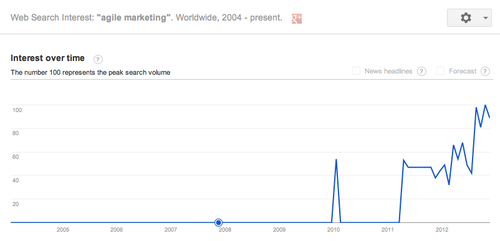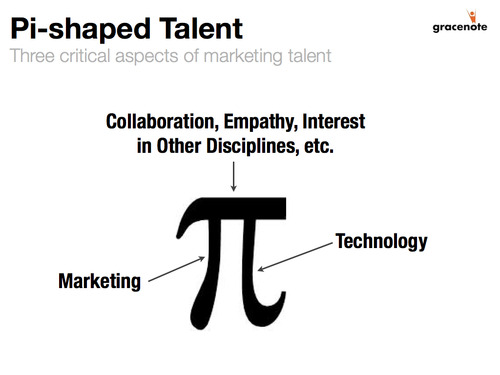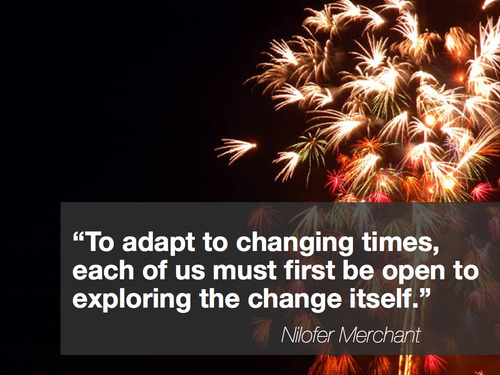We want to get our culture, our agencies, and everyone thinking more like agile developers….The greatest successes for me have always come about from having small, small teams being free to move forward quickly.
– Winston Binch, Partner and Chief Digital Officer, Deutsch LA
Over the past few months interest in agile marketing has soared. You may have noticed much of the buzz on blogs, articles, and tweets from those you follow. If so, you’re not the alone. This graph from Google shows the increase in searches for “agile marketing”—rising from virtually non-exisitent not long ago to a significant topic of interest today.
Chart – Web Search Interest: “agile marketing” 2004 – present.

So, yes, agile marketing is a hot topic. But, what exactly does everyone mean by agile marketing? And, why is the concept suddenly en vogue?
What Is Agile Marketing?
Agile is a discipline picked up from software developers and it’s being applied to marketing teams. Agile marketing is also influenced by concepts promoted by Eric Reis in his book, The Lean Startup, which has taken Silicon Valley by storm. Agile teams follow core principles that shape the way they work. Those principles include:
- a bias toward action;
- responding to change;
- emphasis on collaboration (people and their interactions) and,
- iterative work cycles that deliver something of value.
The basic approach looks something like this. Work gets prioritized into a backlog. The team takes some of the items from the backlog and completes those items within an iteration, which is often called a “sprint” and typically lasts from 1-4 weeks (depicted in the large cycle in the image below). The team meets briefly once each day for a “standup” or “daily scrum” meeting (depicted in the small cycle in the image below). In these meetings, each team member tells the group what he or she worked on yesterday, what he or she will work on today, and whether there are any obstacles hindering progress and productivity.

With agile marketing, many of the same agile concepts and approaches apply. However, some tweaking is required in order to meet the unique needs of the marketing discipline. In agile software development, the output of each iteration is working software. In agile marketing, the output of each iteration is something of value to the organization’s customers. Scott Brinker, the President & CTO of ion interactive, has made the case that—for marketing teams—the output of each iteration should focus on customer experiences. As Scott describes it:
In marketing, the primary objective is remarkable customer experiences. Are the expectations of prospects, customers, and partners being met (or exceeded!) in the interactions we deliver online, in person, on the phone, over mobile devices, and directly through our products and services? This applies from early awareness building and demand generation efforts through to lifecycle customer service.
Many agile software teams work with the concept of a Minimum Viable Product (MVP). A MVP defines the minimum set of features and functionality that allows the product to be deployed, and no more. MVP is a strategy that allows for the rapid and data-driven testing of a new product or product feature. And, the approach was popularized by Eric Reis, in The Lean Startup. Some marketing teams have adapted this concept and created what they call a Minimum Viable Brief (MVB). The MVB focuses on insights that can be gleaned from “real time” digital tools, focuses on multiple ideas and options, and provides room to evolve as customers provide feedback. The MVB allows marketing teams to iterate and test campaigns.
Marketing teams using the agile marketing approach choose to co-locate, either physically or virtually. Many teams work together in a “war room” environment that allows for ease of communication and the exchange of ideas. When not physically together, these teams rely on social and collaboration technologies to work together remotely.
Another aspect of agile marketing teams is the makeup of the team itself. Agile marketing teams combine marketers and technologists into the same team. Gone are the days of the art director and copywriter as the two primary roles on the team (think Mad Men era). Agile marketing teams are made up of creatives, digital experts, developers, and freelancers depending on the project needs.
When selecting people to join the team and developing the talent of each team member, agile marketing teams emphasize what has recently been termed pi-shaped people. These are people who, like the shape of the symbol for pi, are deep in both marketing and technology domains. However, they are also highly collaborative, empathetic, and very interested in other disciplines.

Why is Agile Marketing So Popular?
We are entering an age where agile creativity is going to be an competitive advantage.
– Greg Andersen, CEO, BBH New York
There are several reasons for the popularity of agile marketing. One is the that agile marketing is largely a consequence of the trend of marketing and technology to intersect and move towards each other. Software is at the heart of all modern marketing—from campaign management, content management, listening systems, web applications, display advertising, etc. So, from that point of view, it makes sense that marketers and technologists would borrow ideas and practices from each discipline.
Agile marketing is also a response to the rapid change that is currently disrupting the status quo. Anyone involved in marketing in the past few years can attest to the changes impacting work, marketing opportunities, and customer expectations. The rise of mobile, social, cloud computing, and big data—combined with increased customer expectations for remarkable experiences—has led to the proliferation of technology options, a faster pace, and a rapidly changing landscape. Major changes occur weekly or daily rather than monthly or quarterly. Agile marketing approaches, with the emphasis on responding to change, help address the needs of modern marketing teams.
Perhaps the most important reason for the rise of agile marketing is the nature of the digital and social era. Digital has the ability to be an increasingly measurable and accountable medium. It allows focus on what really, really matters. Agile marketing allows teams to deliver customer experiences that matter quickly, evaluate the real time data about how customers respond, and adjust as necessary. This increased speed and agility is essential for marketers.
What’s Next
While many organizations are having success with agile marketing, the real key is to introduce some agile marketing concepts and adjust as necessary.

There is no one-size-fits-all approach, and teams need to experiment to learn what works best in each environment.
- Have you already adopted agile marketing?
- Is your marketing activity increasingly dependent on technology?
- Are you experiencing the rapid shifts inherent in the digital and social era?
- What other approaches are you finding helpful?



